The best 4 Teachable Alternatives in 2026 (tried and ranked)
Get an insider's perspective on the best Teachable alternatives in 2026. Discover how Esmerise, Kajabi, Podia, Thinkific compare in ease of use, features, pricing, and more.
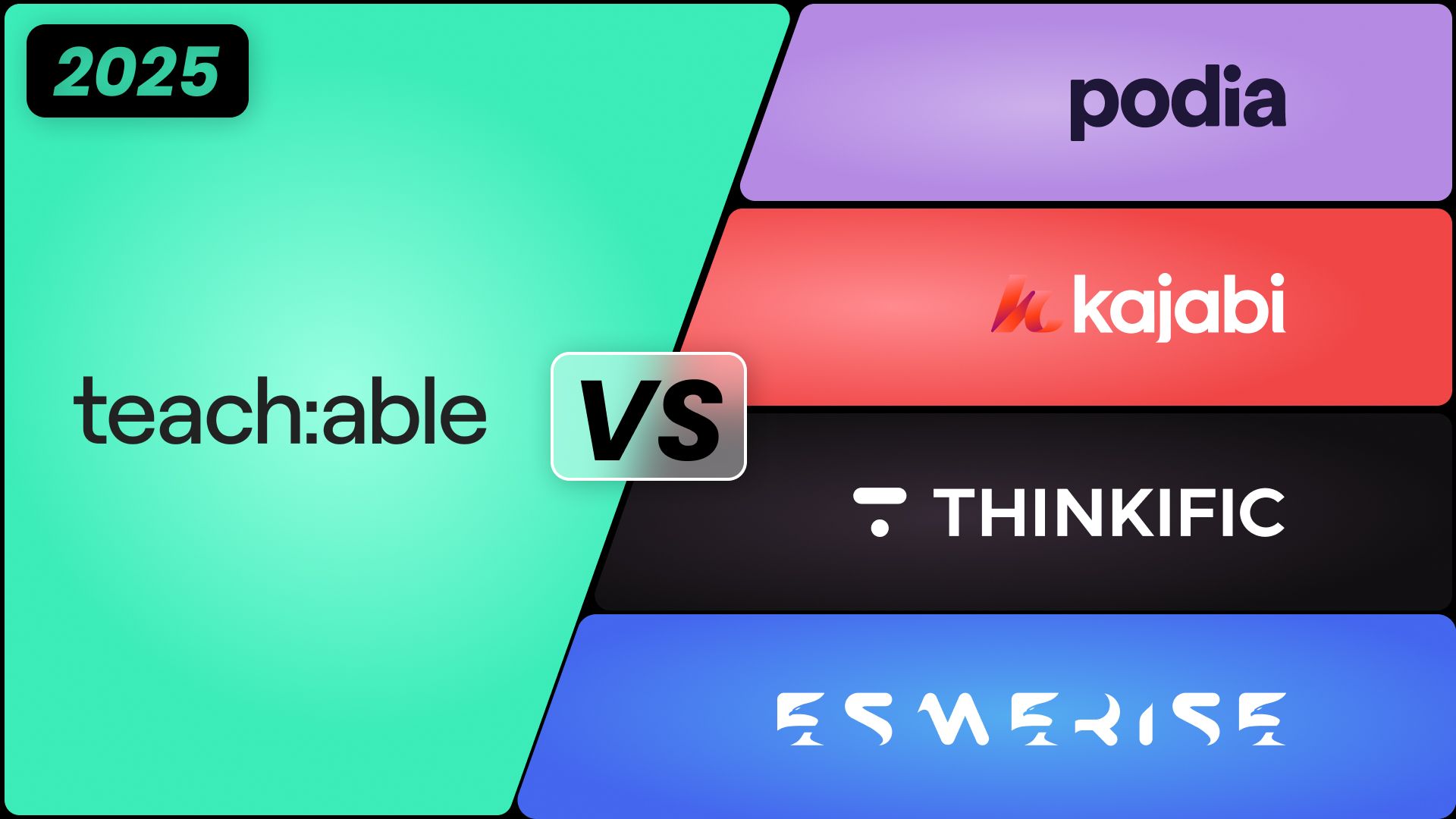
Introduction
Unlike most “Teachable alternatives” articles you’ll find online, which just list features and prices of similar platforms in a superficial way, here you’ll get a different perspective.
We’re the team behind Esmerise, and over the years we’ve helped hundreds of creators migrate not only from Teachable, but also from the other platforms we’ll discuss here. This has given us a unique and practical understanding of how these solutions really work for creators. We know them in depth: exactly where each one shines, where it causes friction, and which specific types of creators it is (or isn’t) really built for.
We’re happy to share all this with you: you’ll find a pragmatic review of all the best alternatives to Teachable. Of course, we’ll also talk about Esmerise, our own platform, which we engineered specifically to address the gaps and opportunities we discovered through direct experience.
Our goal is to give you the clarity you need to make a truly strategic decision. The platform you choose will in fact have a huge impact on your efficiency, your students’ experience, and your business success. Let’s get started!
We’re the team behind Esmerise, and over the years we’ve helped hundreds of creators migrate not only from Teachable, but also from the other platforms we’ll discuss here. This has given us a unique and practical understanding of how these solutions really work for creators. We know them in depth: exactly where each one shines, where it causes friction, and which specific types of creators it is (or isn’t) really built for.
We’re happy to share all this with you: you’ll find a pragmatic review of all the best alternatives to Teachable. Of course, we’ll also talk about Esmerise, our own platform, which we engineered specifically to address the gaps and opportunities we discovered through direct experience.
Our goal is to give you the clarity you need to make a truly strategic decision. The platform you choose will in fact have a huge impact on your efficiency, your students’ experience, and your business success. Let’s get started!
What does Teachable really offer, and what criteria do we use to evaluate the best alternatives?
📌 In a rush? The best platform for success in 2026 is the one that lets you offer a standout product in your market and guarantee your students' success. This is why our analysis points to Esmerise.
• It's the only one that unites courses, community, and advanced gamification in a single ecosystem;
• It's the first to offer you a branded mobile app for you and your students with your own icon, included at no extra cost;
• It's designed to be the simplest to use, supported by a complete video walkthrough;
• It's the platform with the best feature-to-cost ratio, including premium features without the typical extra costs of competitors.
The data confirms it: academies on Esmerise achieve up to 3x the completion rates compared to traditional platforms.
• It's the only one that unites courses, community, and advanced gamification in a single ecosystem;
• It's the first to offer you a branded mobile app for you and your students with your own icon, included at no extra cost;
• It's designed to be the simplest to use, supported by a complete video walkthrough;
• It's the platform with the best feature-to-cost ratio, including premium features without the typical extra costs of competitors.
The data confirms it: academies on Esmerise achieve up to 3x the completion rates compared to traditional platforms.
Teachable is one of the most established and reliable platforms, chosen by many creators as a solid starting point. However, its long presence in the market is reflected in certain limitations that lead many to seek more modern alternatives:
These weaknesses fall within the strategic criteria we will use to evaluate each alternative:
- Very poor mobile experience: the app is available only for iOS students, is not brand-customizable, and does not integrate the community. This effectively excludes all Android users and offers no creator-side management app.
- Limited student engagement: the setup is traditional, with courses and community living in separate areas. The complete lack of native gamification makes it hard to keep students motivated over the long term.
- Less convenient advanced plans: while the basic plan is affordable, to unlock essential growth features (like removing the Teachable brand) you need to upgrade to higher plans, which are less competitive compared to other platforms.
These weaknesses fall within the strategic criteria we will use to evaluate each alternative:
- User experience and ease of use: is the platform an accelerator for your business or a brake that requires constant learning?
- Marketing and sales tools: is the page builder powerful and intuitive enough? Is it easy to integrate with external tools?
- Community and engagement: does the platform combine courses, community, and gamification into a modern learning experience?
- Mobile experience (creator and students): does it offer a single unified, branded app?
- Value for money (real value): is the cost sustainable and justified by the growth features offered?
Kajabi: the powerful all-in-one option
📌 For a more direct comparison, check out our article Teachable vs Kajabi.
| Key Metric | Rating |
|---|---|
| User experience | ⭐️⭐️⭐️⭐️ (well designed but sometimes complex) |
| Community & gamification | ⭐️⭐️⭐️ (separate community, very limited gamification) |
| Mobile experience & app | ⭐️⭐️ (fragmented ecosystem, branded app is expensive) |
| Marketing & sales | ⭐️⭐️⭐️⭐️ (very good, but with restrictive limits on base plans) |
| Value for money | ⭐️⭐️ (very expensive, entry plans not convenient) |
What is it really like to create and follow a course on Kajabi?
Kajabi’s editor is powerful and full of features, which results in a slightly steeper initial learning curve compared to, for example, Teachable. Creators who migrated to Esmerise from Kajabi have often told us that day-to-day use feels cumbersome, with many functions that end up never being used. The student experience is rather traditional, based on a visually unappealing list of lessons and completely separated from the community.The mobile ecosystem is unfortunately its biggest weakness: it is split across three different apps (creator, students, community), creating a confusing user experience. The creator app is also very limited to a statistics dashboard, and although it is possible to have a branded app for students, it requires an expensive monthly add-on.

Community and gamification
Kajabi offers a dedicated platform, Kajabi Communities, which is a solid choice if you want to sell a community as a standalone product (and very powerful for this specific use). However, it’s designed more as a separate entity, likely developed over time following the success of platforms dedicated exclusively to community features. The limitation becomes clear when you try to integrate it with courses: the community is intended to be its own separate world, as shown by the fact that students need one app for courses and another for the community. Native gamification is also absent within courses and is only available, with some basic features, in the community platform.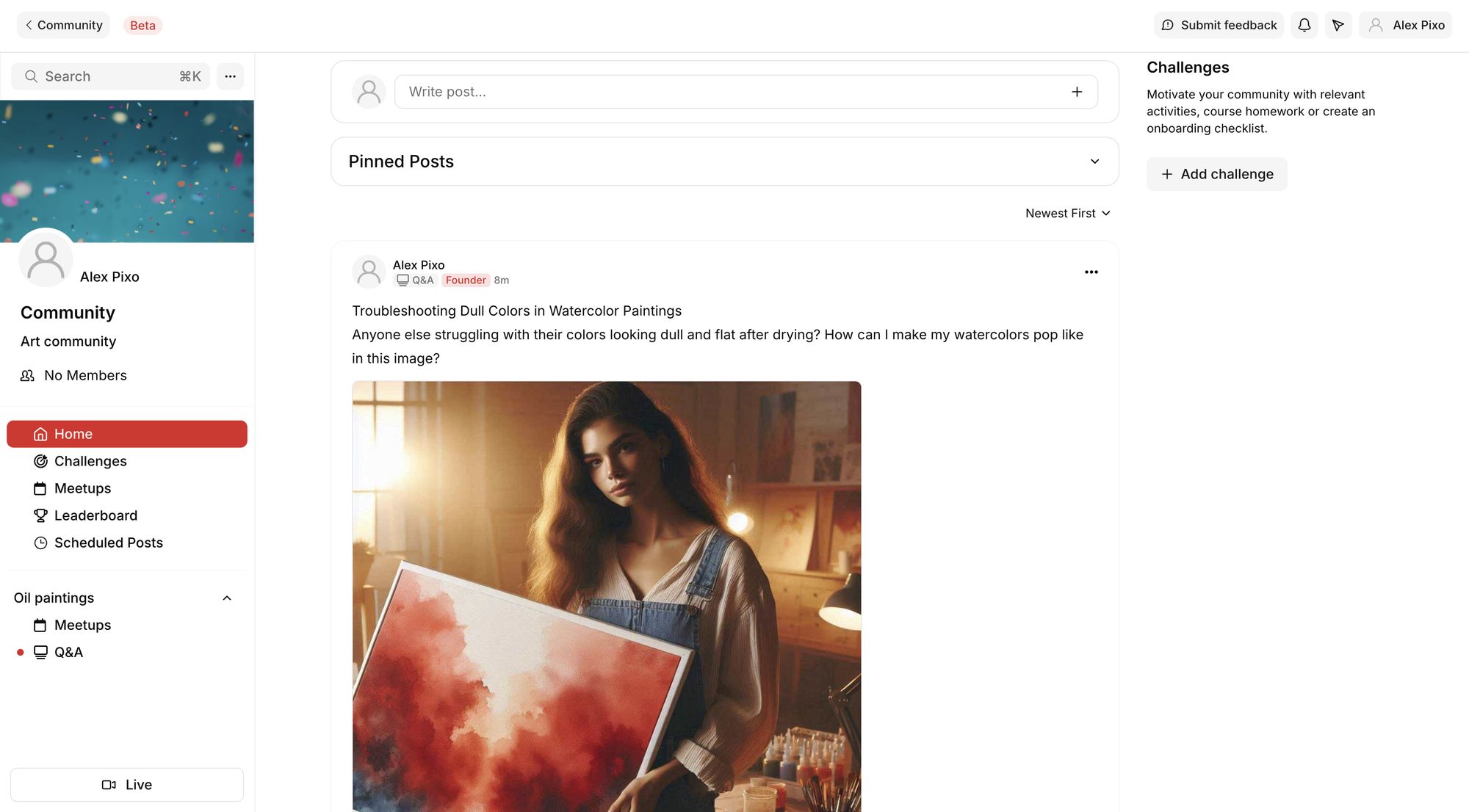
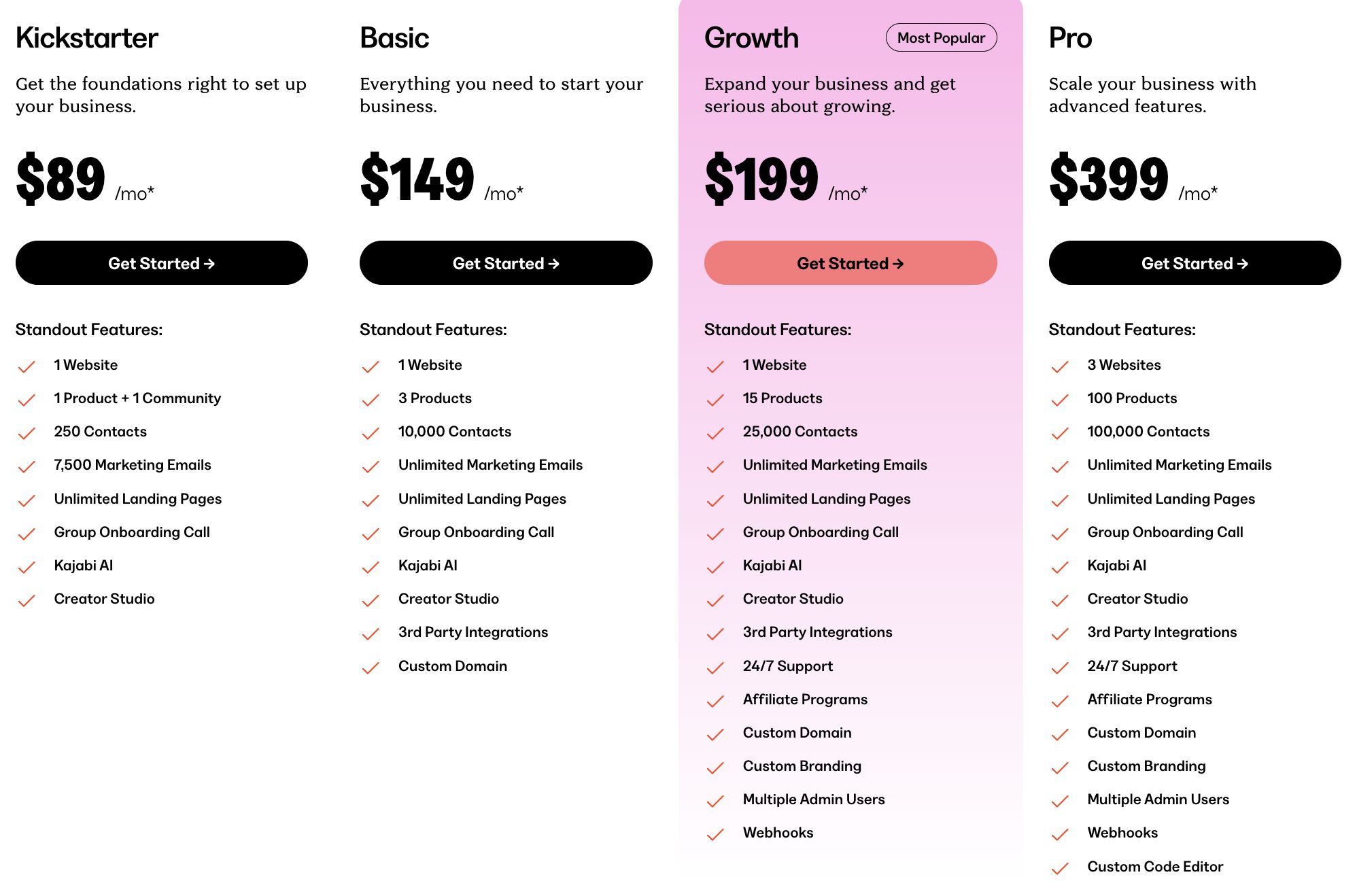
Our Insider Perspective
💡 Kajabi is the choice for those with a high budget who need a mature 'all-in-one' marketing ecosystem. However, its complexity, prohibitive costs, and a fragmented, dated user experience are the main reasons why creators we've helped have chosen to migrate. It's a powerful platform, but often oversized and not agile enough for the needs of the modern creator.
Podia: the simple and affordable option
| Key Metric | Rating |
|---|---|
| User Experience | ⭐️⭐️⭐️⭐️⭐️ (Extremely simple and intuitive) |
| Community & Gamification | ⭐️⭐️ (Functional community but separated, gamification absent) |
| Mobile Experience & App | ⭐️ (No native app for creators or students) |
| Marketing & Sales | ⭐️⭐️⭐️⭐️⭐️ (Excellent page builder and flexible product management) |
| Value for Money | ⭐️⭐️⭐️⭐️⭐️ (Great value, generous plans) |
What is it really like to create and take a course on Podia?
The course creation experience on Podia is one of its strongest points. The interface is clean, modern, and very intuitive, making it quick and frictionless to set up your courses. However, the student experience, while visually appealing, still relies on the traditional list of contents. The community, although functional, remains a separate product and is not smoothly integrated into the lessons, which limits contextual interactions.The biggest compromise of this approach shows up on mobile: Podia doesn’t offer any native app, for creators or students. While the website is well-optimized for mobile browsers, the total absence of a dedicated app is a significant strategic limitation in 2026, reducing accessibility and engagement for users on the go.
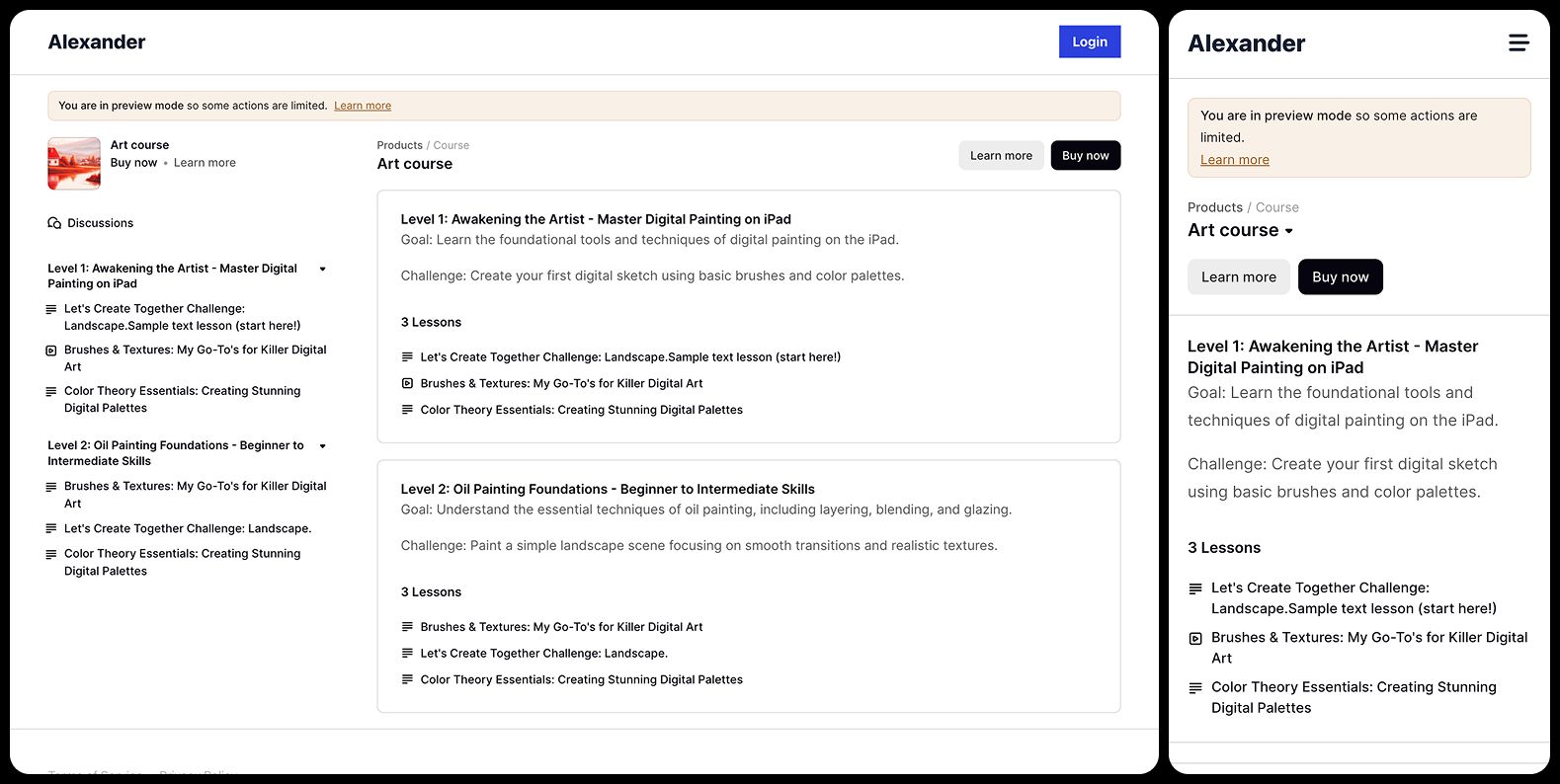
Community and gamification (student engagement)
Podia offers a well-designed and flexible community feature that lets you create both public and private spaces. However, like other platforms from its generation, the community is treated as a separate product from the course experience (even if it can be linked, like in Teachable). Gamification, on the other hand, is completely missing. In short, the lack of a dedicated app, absence of gamification, and a community that’s detached from the learning flow may result in a less engaging experience for students.
What is it like to sell and monetize your digital products on Podia?
Podia stands out for those selling not only courses, but also digital downloads, webinars, and community memberships. Payment processing is handled through the usual partners, Stripe and PayPal, and you’ll need to connect an account to receive funds. One of Podia’s biggest strengths is its page builder: it’s one of the most modern and intuitive on the market, letting you create professional sales pages effortlessly using well-designed templates. There’s also a built-in basic email marketing system (with a small additional cost) and a solid set of direct integrations.How much does Podia really cost?
Its pricing is one of its strongest advantages. The plans are simple, transparent, and very affordable. The base "Mover" plan (about $39/month) already offers unlimited products with a small 5% fee, while the "Shaker" plan (around $89/month) removes it entirely. There are no hidden fees for essential features, making Podia one of the most budget-friendly alternatives on the market.
Our Insider Perspective
💡 Podia offers one of the best value-for-money ratios on the market. It’s extremely user-friendly, and its page builder is excellent, making it ideal for those selling multiple digital products. However, its biggest drawback is the complete lack of a mobile app for both creators and students. This is the main reason creators cite when migrating to Esmerise.
Thinkific: the cooler traditional platform
📌 For a more direct comparison, check out our article Teachable vs Thinkific.
| Key Metric | Rating |
|---|---|
| User Experience | ⭐️⭐️⭐️⭐️ (Intuitive and functional, but not excellent) |
| Community & Gamification | ⭐️⭐️ (Community separated from courses, no gamification) |
| Mobile Experience & App | ⭐️⭐️ (Student app has issues, branded option is very expensive) |
| Marketing & Sales | ⭐️⭐️⭐️ (Flexible with Thinkific App Store, complex page builder) |
| Value for Money | ⭐️⭐️⭐️⭐️ (Great entry/mid plans, but removing their branding is very expensive) |
What is it really like to create and take a course on Thinkific?
Creating a course on Thinkific is a functional and familiar experience. The editor uses a classic layout that allows you to organize your content neatly, though the interface can sometimes feel confusing and less visually polished than other alternatives. For students, the learning experience sticks to the traditional list of lessons, which feels uninspiring and isolated, since community features are kept separate from the learning flow.When it comes to mobile, Thinkific doesn’t shine. For you as a creator, there’s no dedicated management app, so you’re forced to use the browser with some limitations. For students, there’s an app for iOS and Android, but it receives fairly critical reviews on iOS and can’t be customized with your brand unless you pay for a very expensive add-on starting at $199/month.

Community and gamification (student engagement)
Like Teachable and Podia, Thinkific also shows signs of its “age” in its architecture. Its community features, while available and well-structured, exist in a separate environment from the courses. This means interaction doesn't happen contextually within lessons, but rather in a dedicated space. As for gamification, there are no native features: adding points or badges requires external integrations with additional cost and complexity.In summary: Thinkific’s approach to engagement is traditional; features exist, but they’re not integrated, resulting in a disconnected experience for the student. It’s a solid platform for delivering content, not for easily building a truly interactive learning ecosystem.

What is it like to sell and monetize your digital products on Thinkific?
Thinkific provides a solid selling system, with flexible payment management through an integrated solution (Thinkific Payments) and direct gateways. Its biggest marketing asset is the Thinkific App Store, which allows you to expand functionality through many third-party integrations. However, as mentioned earlier, its native page builder is cluttered and less intuitive compared to competitors.How much does Thinkific really cost?
The base plan (about $48/month) is a good starting point, with unlimited courses and zero transaction fees. The issues arise when your brand needs to grow: to remove Thinkific’s branding, you’ll need to upgrade to the $195/month plan, and a custom-branded app will cost you an additional $199/month. These “hidden costs” make the platform extremely expensive for anyone looking to scale with advanced features.
Our Insider Perspective
💡 Thinkific is a solid and reliable platform, great for delivering traditional courses with a good base plan. The problem arises when you want to scale: the costs to become a professional brand are prohibitive. Removing their branding requires a $195/month plan, and a custom-branded app costs an additional $199/month. Creators who migrate to Esmerise usually do so to find a more engaging and modern student experience, more sustainable costs, and in some cases, greater ease of use.
Esmerise: the best overall platform for value and innovation
What’s it really like to create and follow a course on Esmerise?
Esmerise redefines course creation by removing the divide between backend and frontend. As a creator, you build and edit content "in-context", seeing exactly what your students will see in real time. For them, learning isn’t just a list of lessons, it’s an integrated learning ecosystem, where courses, community, and gamification work together to dramatically boost engagement and completion rates.This philosophy extends seamlessly to mobile. Esmerise offers a unified native app for both you and your students, a unique feature in this industry. You can manage your entire academy from your phone with no limitations. Your students access all content and interactions in a consistent and professional space. Most importantly, the app is customizable with your icon starting from the mid-tier plan, without the high extra costs typical of other platforms.
The platform is also fully localized in 4 languages (Italian, English, Spanish, and French), with customer support available in all of them, and includes a full video walkthrough to help you make the most of every feature.

Community & Gamification (Student Engagement)
Modern learning science is clear: isolated and passive learning doesn’t work. Studies published in leading academic journals (such as Computers & Education and the British Journal of Educational Technology) consistently show that the most effective online courses create synergy between content, social interaction, and motivation. When students feel part of a shared journey and see their progress recognized, completion rates increase dramatically.Esmerise was built from the ground up on this principle, offering a truly integrated learning environment that includes the option to activate a forum section and group chat, both seamlessly embedded within the course space.
This is further enhanced by a flexible and native gamification system. You can create a real internal economy 🏆 with points, badges, and rewards to recognize consistency and progress, turning learning from a passive task into an engaging journey.
Community and gamification are no longer add-ons, but core elements of the new generation of digital learning paths.
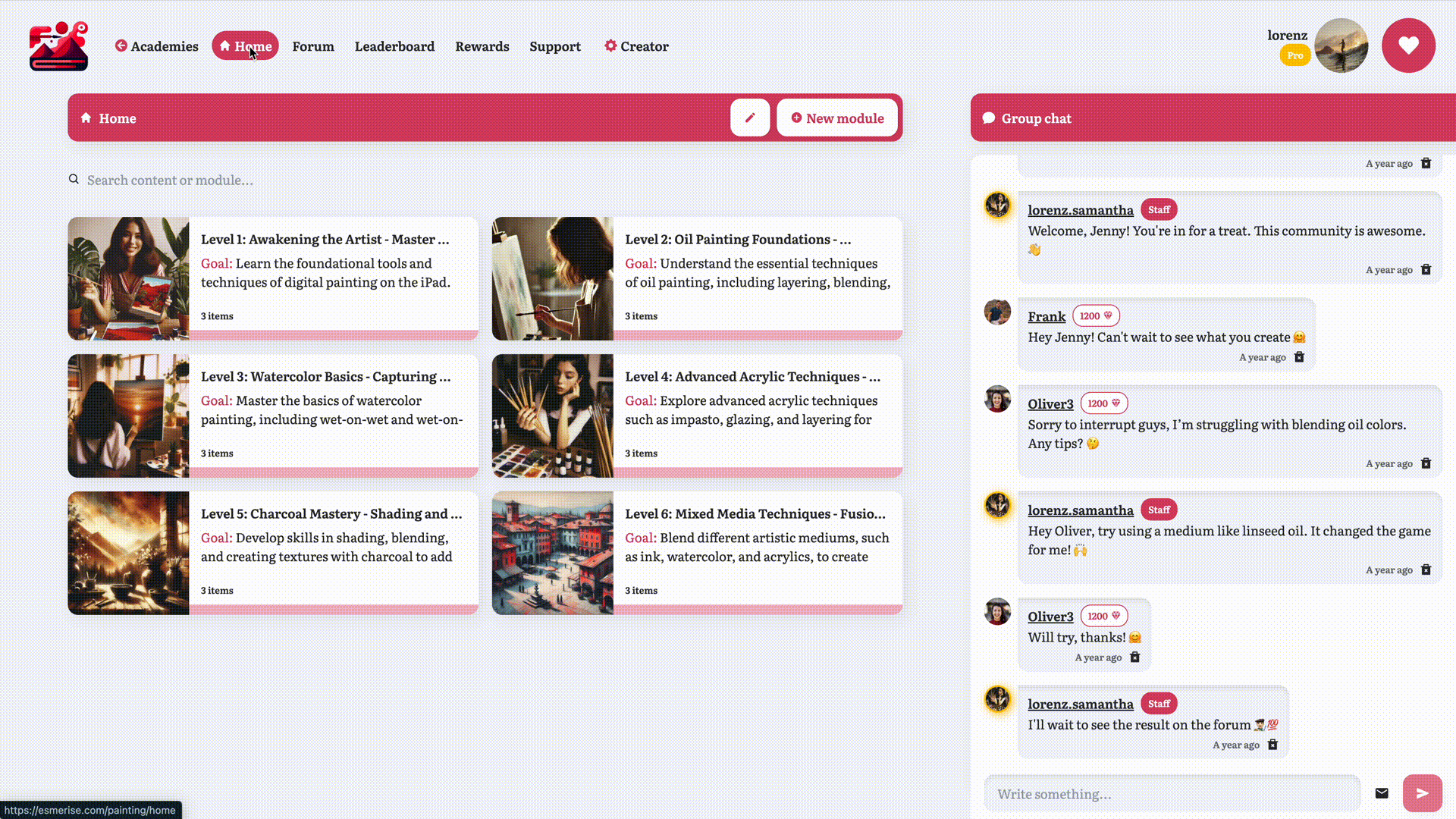
How does selling and monetizing your digital products work on Esmerise?
Esmerise takes a centralized and powerful approach, allowing you to create products that combine courses, community, and gamification in one single offer. Payment management is extremely flexible (Stripe, PayPal, installments, multi-currency), and the strategic advantage lies in the many direct native integrations with leading industry tools, eliminating the need for Zapier for common automations.How much does Esmerise really cost?
Esmerise pricing plans are designed to include premium features without outrageous add-on fees. The basic plan already includes unlimited products, but the real competitive edge is in the intermediate tier: the fully customizable mobile app with your brand is included, a feature that on other platforms can cost hundreds of euros more per month. The goal is to give you all the tools to grow, with no surprises. We believe that Esmerise currently offers the best value for money on the market, whether you're just starting out or already have an established brand and want to stand out.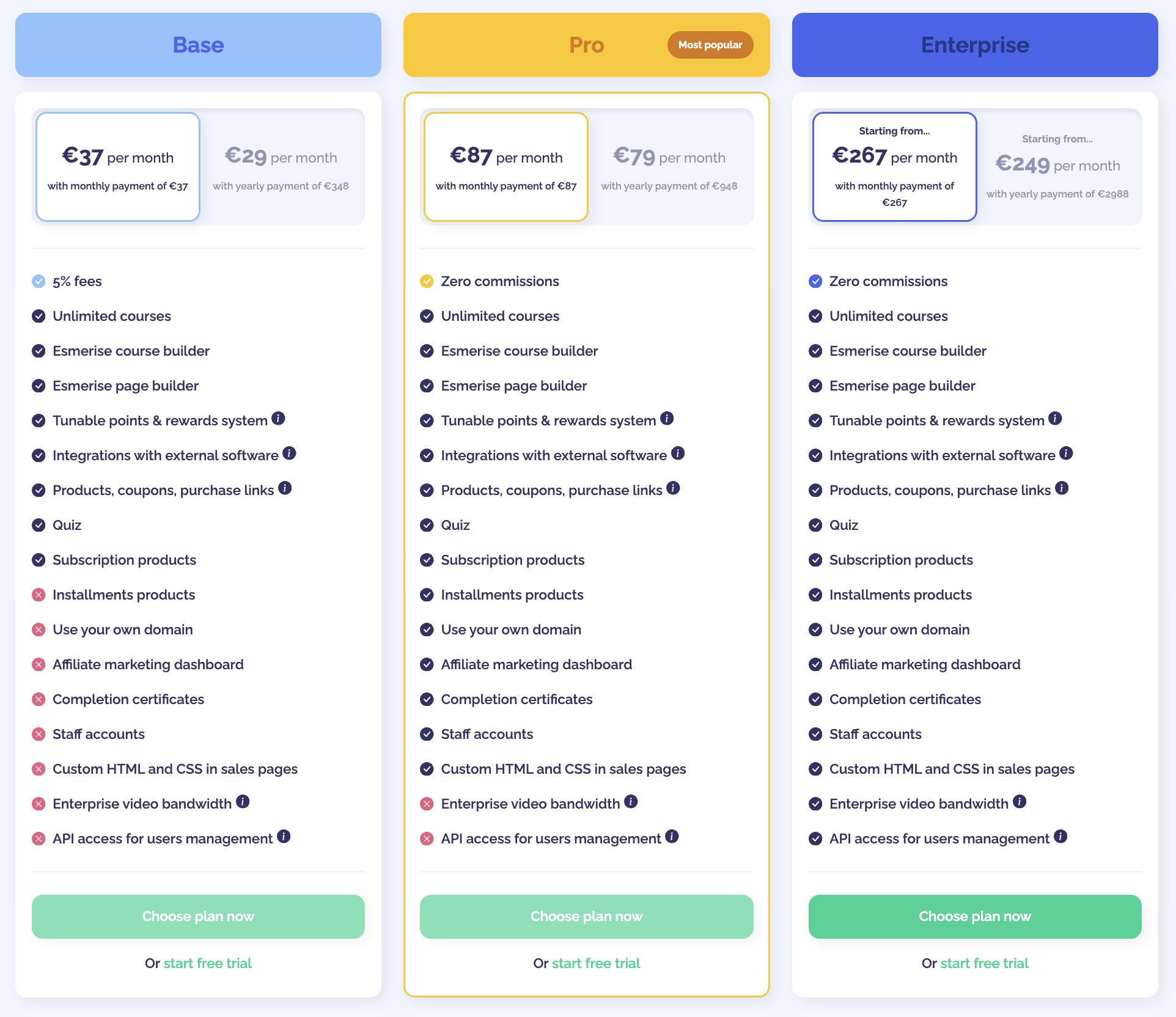
Our Insider Perspective
💡 Esmerise is not just an alternative, but a direct response to the limitations of traditional platforms. Instead of separating courses, community, and mobile, we’ve integrated everything into one powerful and intuitive ecosystem. An exceptional student experience is the biggest accelerator for a creator's business, and our entire platform is built on this principle, from the app included in the price, to the human support that guides you in your growth, to the revolutionary 'in-context' creation experience. Esmerise is the best alternative for those who want to stand out from the competition and build a successful business in the 2026 landscape.
Final comparison: Kajabi vs Podia vs Thinkific vs Esmerise
| Key Aspect | Kajabi | Thinkific | Podia | Esmerise |
|---|---|---|---|---|
| Usability & interface | ⏳ Learning curve 🧩 Complex interface | ✅ Simple 🧩 Less polished | ✅ Very simple ✨ Modern interface | ✅ Intuitive & smooth ✨ In-context interface |
| Student experience | 👴 Traditional 🧊 Isolated community | 👴 Traditional 🧊 Isolated community | 👴 Traditional 🎨 Clean design | 🎓 Integrated experience 🤝 Social learning |
| Marketing & sales | 📄 Powerful page builder 🔒 Limits on basic plans | 📄 Confusing builder 🔗 Great Thinkific App Store | 📄 Excellent builder 📧 Integrated email marketing (extra) | 📄 Excellent builder 🔗 Native integrations |
| Community & gamification | 🟡 Separate 🟡 Limited gamification | 🟡 Separate ❌ Absent | 🟡 Separate ❌ Absent | ✅ Integrated 🏆 Advanced gamification |
| Mobile & white-label app | 😵💫 3 separate apps 💸 Costly extra ($199/mo) | 📉 Yes, but poor iOS reviews 💸 Very expensive ($199/mo) | ❌ No app ❌ Not available | ✅ Unified app 🎁 Included & brandable |
| Pricing & value | 💸 Expensive 🔒 Basic almost useless | 💲 Affordable start 💸 Higher plans less convenient | ✅ Great value ♾️ Generous plans | ✅ Great value 🎁 Unique features included |
Final verdict: which platform to choose in 2026?
We hope this in-depth analysis has been helpful. As we’ve seen, the key is choosing the platform that offers the best experience to build a successful business in 2026. The online learning world has evolved, yet many legacy platforms are struggling to keep up, forcing you to compromise: a solid course but with an outdated student experience, or a lively community with weak teaching tools (like Skool and similar).
Esmerise was born from exactly this: listening to the frustrations and needs of hundreds of creators who, like you, wanted more. We engineered from the ground up a new learning ecosystem where courses, community, and gamification finally work together. Because when students are more engaged, they don’t just complete your courses, they become a loyal community that supports your long-term growth.
Along the way, we removed all unnecessary complexity and added industry-first features, like a unified PWA app customized with your brand (included, not an expensive extra), human multilingual support 🇮🇹🇬🇧🇪🇸🇫🇷 to support you along the way, and affordable pricing plans with no artificial limits, designed to grow with you.
Esmerise was born from exactly this: listening to the frustrations and needs of hundreds of creators who, like you, wanted more. We engineered from the ground up a new learning ecosystem where courses, community, and gamification finally work together. Because when students are more engaged, they don’t just complete your courses, they become a loyal community that supports your long-term growth.
Along the way, we removed all unnecessary complexity and added industry-first features, like a unified PWA app customized with your brand (included, not an expensive extra), human multilingual support 🇮🇹🇬🇧🇪🇸🇫🇷 to support you along the way, and affordable pricing plans with no artificial limits, designed to grow with you.
Start building your business today.
Frequently asked questions
What is the best alternative to Teachable in 2026?
Podia and Thinkific are the most similar platforms and represent a good starting point. Kajabi positions itself as the most comprehensive all-in-one solution, but at a significantly higher cost. If you're looking for a true leap in modernity, user experience, and overall value, we believe the ideal choice is Esmerise, thanks to its integrated ecosystem that combines courses, community, and a branded app included.
Is there a Teachable alternative with a better mobile app?
Yes. Teachable's app is very limited: only for iOS students and not customizable. Esmerise offers a clearly superior alternative with a single unified app for creators and students, fully brandable, and included in the plans. Kajabi and Thinkific also offer customizable apps, but only as a costly add-on, while Podia has no app at all.
Why should I look for a Teachable alternative?
The main reasons are a very poor mobile experience, a dated and unengaging student experience (separate community, zero gamification), and advanced plans that become expensive for the features offered. If you want a more modern experience and greater value for your students, it's time to look elsewhere.
Which platform is more powerful than Teachable for marketing and automation?
Kajabi is more powerful for marketing, offering an 'all-in-one' ecosystem with funnels, advanced email marketing, and a CRM. However, it is much more expensive and complex than Teachable. Esmerise offers a balanced alternative, with a powerful page builder and numerous direct native integrations that eliminate the need for Zapier for common automations, all while maintaining a competitive price.
What is the most cost-effective Teachable alternative for scaling?
While Teachable's base plan is competitive, the costs to scale (e.g., custom domain) make it less affordable. Podia offers great value with unlimited products for a flat fee. Esmerise provides the best value for growth by including premium features like a fully branded app in its mid-tier plan, which on other platforms is a very high extra cost.






